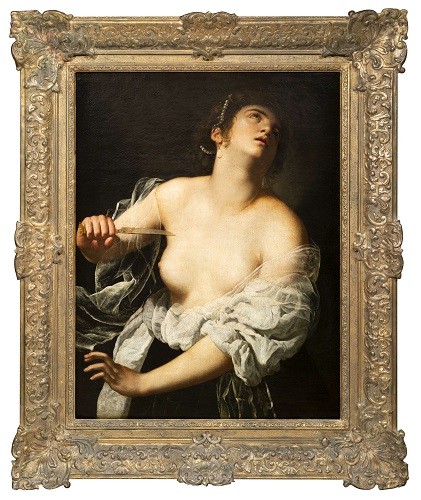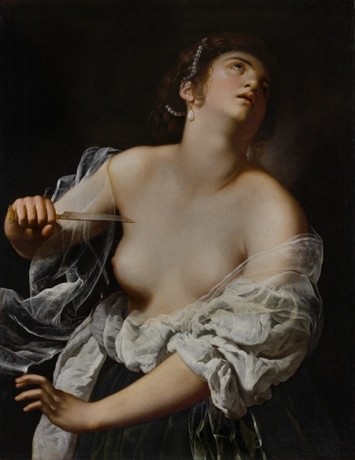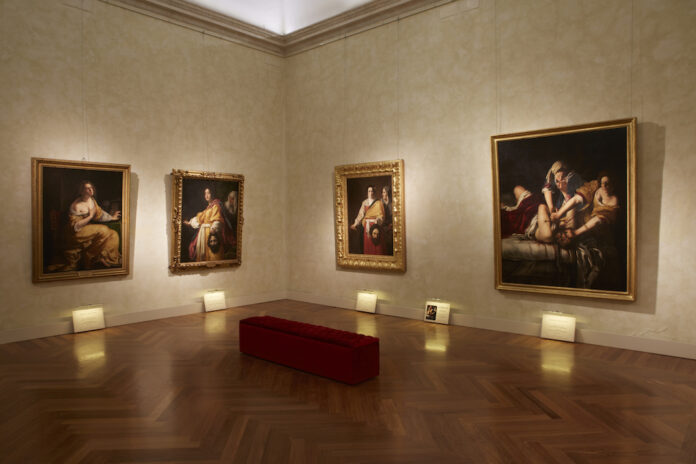The Getty Museum in California has become the owner of a painting by the Baroque artist Artemisia Gentileschi. It depicts the Roman heroine Lucrezia about to stab herself in the heart with a dagger. According to legend, Lucretia, raped by the son of the Roman king Tarquinius, demanded that her relatives avenge her and then committed suicide before their eyes. Her act provoked the overthrow of royalty in Rome and the founding of the Roman Republic, according to Artnet.

“Lucretia” by Artemisia Gentileschi first became famous in 2019 when it was sold by the Parisian auction house Artcurial. The painting’s owners acquired it in Cannes in 1980, and since then it has remained in a private collection in Lyon for several decades, remaining unknown even to specialists.
Lucretia’s suicide was a theme to which the artist returned repeatedly in her art. Another “Lucretia” is known, sold at auction in 2018 for $2.2 million. The earliest known “Lucretia” was painted around 1623 when Artemisia Gentileschi was living in Rome. It is now in the private collection of Gerolamo Etro in Milan.
Auction house experts in 2019 dated the painting between 1630 and 1635, the late period of Artemisia Gentileschi’s work when the artist lived in Naples. However, specialists at the Getty Museum believe that the painting was completed earlier, around 1627 when Artemisia Gentileschi was in Venice. In their opinion, the style of the painting “demonstrates a deep passion for the artistic heritage of 16th-century Venetian painting, especially the female protagonists of Titian and Veronese paintings.”

There is other evidence in favor of the Venetian hypothesis. In 1627 a pamphlet was published in Venice with poems about the paintings of Artemisia Gentileschi. Two poems were devoted to the artist’s self-portrait, one each to the paintings Susanna and The Sleeping Cupid, and three poems to Lucrezia, presumably the very one that is now in the Getty Museum collection. The author of the poems was most likely the noble Venetian Giovanni Francesco Loredan, poet and writer, founder of the scholarly community Accademia degli Incogniti, who was among Artemisia Gentileschi’s close acquaintances during her life in Venice.
“With the discovery of new documents and new paintings over the past 20 years, our understanding of Artemisia’s art has become much more complex and nuanced. The newly discovered work sheds new light on a crucial and hitherto underappreciated moment in her career when the artist moves from the caravaggism that was the hallmark of her formative period to a more refined and idealized style that would characterize her maturity,” says Davide Gasparotto, senior curator of paintings at the Getty Museum.
The museum is now closed to the public because of quarantine, but it is expected to reopen in the next few weeks. Museum officials promise that by then “Lucretia” will have taken up residence in the exhibit.
“The Death of Lucretia” by Artemisia Gentileschi to be on display at the Getty Museum in Los Angeles
Artemisia Gentileschi’s Death of Lucretia depicts a woman on the verge of a breakdown. The portrait, painted around 1627, depicts the legendary heroine of ancient Rome pointing a dagger at her naked chest just seconds before stabbing herself.

Like many of Gentileschi’s works, her Lucrezia has long since been forgotten. Soon, however, this Baroque masterpiece will be back in the public domain after it had been hidden away in private collections for centuries.
The Los Angeles Getty Museum, which recently acquired the painting for an undisclosed price, plans to show the striking scene once it is rediscovered. According to Jessica Gelt of the Los Angeles Times, the museum has not yet announced a set date but plans to begin welcoming visitors “in the coming weeks.
“[Lucretia] is a vivid and compelling example of Artemisia’s most significant object type, a representation of dynamic female figures [who] seem to control their own destiny,” Getty Museum curator David Gasparotto said in a statement. “With its lyrical and subtle expressiveness, creamy paste, and vibrant painting style, the painting also suggest new directions in her artistic journey,” Gasparotto states.
Caroline Goldstein of Artnet News notes that Lucretia reappeared in 2019 after “languishing” for decades in a private collection in Lyon, France. The work sold at auction for $5.3 million, setting a world record for Gentileschi and six times its estimate.
The artist’s paintings are incredibly rare: only about 40 of her paintings are in public collections, and few are in the United States.
The tragedy of Lucrezia, a noblewoman whose rape and subsequent suicide are traditionally thought to have sparked the revolt that launched the Roman Republic, was a popular subject for artists of the 16th and 17th centuries, including artists such as Rembrandt van Rijn, Sandro Botticelli, and Titian.
Gentileschi – herself a survivor of sexual abuse – returned to the subject “with some frequency,” painting several versions throughout her career, writes Jesse Locker for Art Herstory.
Gentileschi was born in Rome in 1593, Gentileschi’s first drawing teacher was her father Orazio. A renowned painter himself, Orazio realized that his daughter had artistic potential at an early age: he wrote in 1612 that she “in three years had become so accomplished that I can venture to say that today there is no equal for her.” Other contemporaries also began to applaud Gentileschi’s abilities, and in 1616 she became the first woman to attend the Florentine Academy of Fine Arts.
Although the precocious artist achieved a number of professional successes beyond her years, her personal life was marked by difficulties. When Gentileschi was only 18 years old, one of her mentors, Agostino Tassi, raped her. Because women were forbidden to press rape charges at the time, Orazio acted on his daughter’s behalf, detailing the decline in “barter value” caused by losing her virginity, as Sarah Cascone wrote for Artnet News in 2018.
In the years that followed, Gentileschi had to undergo a long, grueling ordeal. She was even tortured to prove the veracity of her testimony. In the end, Tassi was sentenced to “a short period of exile, which he ignored,” according to the New Yorker.
“Her achievements as a painter of strong and dramatic story subjects are all the more remarkable for the violence and prejudice she experienced in her personal life, which is palpable in ‘Lucretia’s Suicide’ and her other paintings in which the protagonist is the abused or abused woman,” said Getty Museum director Timothy Potts in a statement.
Potts adds that the recently acquired painting “will open a window for our visitors to important issues of injustice, prejudice, and abuse that lurk behind the seductively beautiful surfaces of such works.”
Many of Gentileschi’s paintings touch on similar themes. “Susanna and the Elders” (1610), for example, depicts a woman who rejects two men’s demands for sexual favors despite their threat of blackmail. Other canvases, such as Judith Beheading Holofernes (c. 1612-1613), “show women actively correcting their misdeeds.”
Countless artists have depicted biblical subjects throughout history, but none of their works exudes as much energy as Gentileschi’s paintings: in this scene, Judith and her maid restrain the Assyrian warlord as they cut off his head. Crimson arcs of blood emanate from Holofernes’ neck as the women hold him down.
Paintings like this – and the recent Lucretia – may help scholars studying Gentileschi’s work better understand the artist’s work.
“With the discovery of new documents and new paintings, our understanding of Artemisia’s art has become much more complex and nuanced over the past twenty years,” Gasparotto said in a statement. – This newly rediscovered work sheds new light on a crucial and hitherto overlooked moment in her career.”

























